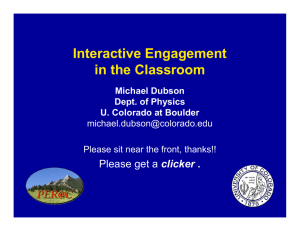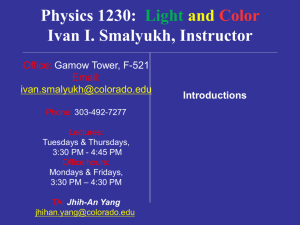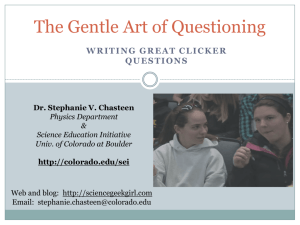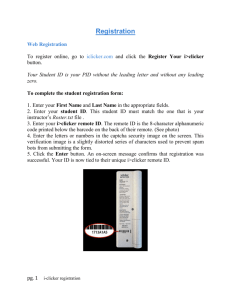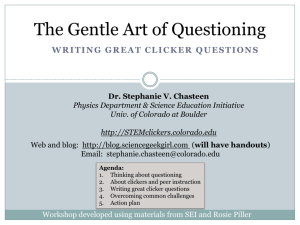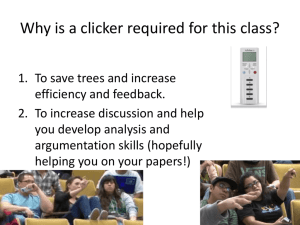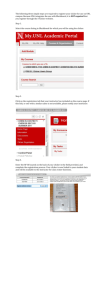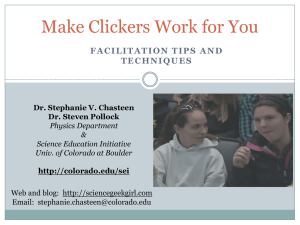Course Transformation at all levels?
advertisement
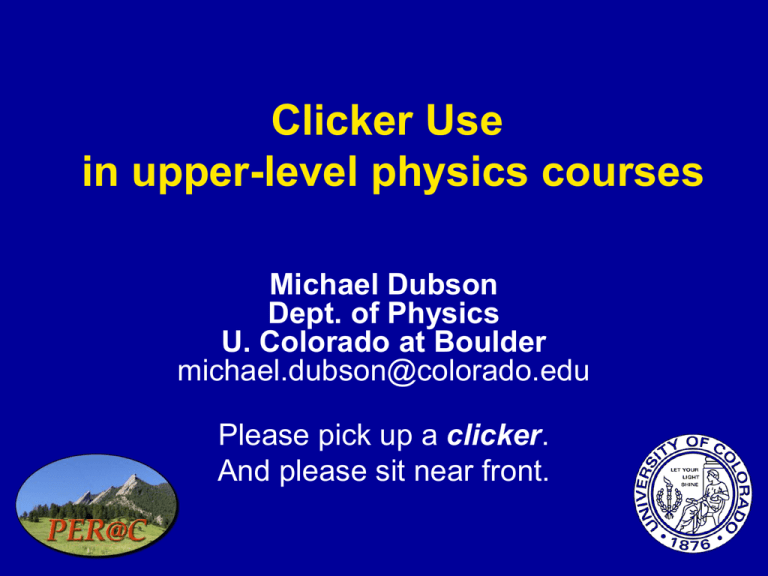
Clicker Use in upper-level physics courses Michael Dubson Dept. of Physics U. Colorado at Boulder michael.dubson@colorado.edu Please pick up a clicker. And please sit near front. Physics Education Research University of Colorado at Boulder • Physics faculty: Noah Finkelstein Steven Pollock Michael Dubson Kathy Perkins Carl Wieman • Postdocs: Stephanie Chasteen Laurel Mayhew Sam McKagan Archie Paulson Ph. D. students: Charles Baily Noah Podolefsky Chandra Turpen Lauren Kost School of Ed collaborators: Prof. Valerie Otero Bud Talbott Kara Gray http:// per.colorado.edu Novice vs. Expert: CU Physics course reforms since 1997: • • • • • • • Peer Instruction Conceptual exams Interactive Homework Helproom Washington Tutorials/ undergrad TA's Pre/post tests Team-teaching •All freshmen classes and Physics III transformed •Strong efforts in upper-level Math Methods, QM, E&M, Stat Mech At U.Colorado Boulder, 70% of undergrads (17,000) use clickers in >100 courses in 15 departments. A Difficult Question: What Letter Am I thinking of? A B C D E Confer with your neighbors, then vote. Worse Concept Tests • merely test recall • blind application of formula/recipe • many numbers Better Concept Tests • • • • qualitative understanding students provide next step in the lecture use familiar skill in unfamiliar context support a learning goal What happens during my QM1 or StatMech class ? • 50 min lecture: Clicker question running when students enter ~ 30 min lecture in 10 min chucks ~ 20 min on 3 or 4 concept tests, discussion, demos • • • • Group discussion enforced with clicker groups Mostly traditional (difficult) homeworks Exams mix of computational and qualitative/conceptual Formula sheet on exams. A ball rolls back and forth in a valley. Eventually, the ball slows and stops. We never observe the reverse. Consider : •Conservation of energy (1st Law of Thermo) •Entropy of an isolated system increases (2nd Law) •Conservation of momentum The reverse process never occurs because this would violate: A) 2nd Law only B) All three C) Cons. of energy & cons. of mom. D) Cons.of energy & 2ndLaw E) Cons.of mom. & 2ndLaw Giving the answer STOPS discussion • Elicit student reasoning, before giving answer. • Understanding why wrong answers are wrong is as important as why right answers are right. • Value reasoning above answer. A right answer without a reason is useless. A wrong answer for a good reason has value. Student must be convinced that •understanding = high exam score. •memorizing answers to specific questions = low exam score. 2.5 5 charges, q, are arranged in a regular pentagon, as shown. What is the E field at the center? q q q q q A) Zero B) Non-zero C) Really need trig and a calculator to decide A plane wave, incident from the left, tunnels through potential barrier. E-eigenstate solution has A) the same wavelength on both sides of the barrier V B) a smaller wavelength after tunneling C) a larger wavelength after tunneling Re[y] l same l x l l smaller l larger l E 50% answered (B) due to misuse of a rule: in deeper parts of well V(x), eigenstates have shorter wavelength (bigger KE) and smaller amplitude (shorter dwell time) Students tend to ... • remember the first thing told • over-generalize So.. Be careful how you introduce a topic. Design CTs to test limits of validity. Griffiths, Intro to QM 2nd Ed. The ground state energy of a finite square well is ______ than the grd state energy the infinite square well with the same width a A) the same B) higher C) lower ? a a How do you make up good Concept Tests? • Key points in lecture make with CT Don't tell. Ask. • What is my learning goal? Test with CT • Listen in on student-student conversations in the Helproom. Physics HelpRoom • All TA's and faculty hold office hours here. • Hours staggered, room is always staffed. What is f (x1 , x 2 ) dx d(x x1 )d(x x 2 ) ? A)Zero B) 1 C) 2 D) d(0) E) d(x2 – x1) Can the wavefunction Y(x,t) describing an arbitrary physical state always be written in the form Y( x, t ) y n ( x) exp( iEn t / ) where yn(x) and En is solution of Ĥ yn (x) En yn (x)? A) Yes Thanks to Chandralekha Singh, U. Pittsburg B) No Peer Instruction/ ConcepTests, Eric Mazur, Harvard 1997 Crouch and Mazur, Am. J. Phys. 69, 970 (2001) Also see: Beatty et. al., Am. J. Phys. 74, 31 (2006) Reay et al., Am. J. Phys. 73, 554 (2005) Poor use of clickers.. • solely for taking attendance • for quizzes or high-stakes testing • only occasionally, or at set times Better use of clickers.. • • • • • Integrated into lecture, frequent Require peer instruction Mix of difficulty: very easy to very difficult CTs Generous credit for any answer Low grade impact (~2%) Problem: Good CTs lead to good class discussion, eats into lecture time Solution: Stop complaining. Avoid long derivations in lecture: • Create HW problems that test knowledge of derivations. • Detailed derivations online or in assigned reading. • Derive in class only if making point testable with CTs Golden Rule of Lecture. It's OK to lecture less, because they're not listening anyway. (Scribe mode listening) Use Concept Tests & Peer Instruction : Active learning better than passive learning Physics students are very busy (and human): They have extensive training in : • Symbol manipulation • Getting the right answer • Effort-minimization • Survival They have little training in: • Sense-making • Articulation of ideas • Prioritization of knowledge • Group work • Solving vague problems Another Golden Rule of Lecture. Emphasize qualitative reasoning and conceptual understanding. • in lecture • on homeworks • on exams It doesn't matter if they can compute the acceleration, if they don't know what acceleration is. Two-way conversations with students are vital, because students can misinterpret what we say. “Pearls Before Swine” by Stephan Pastis, 2002. Concept Test An unopened bottle of Champagne, equipped with a pressure gauge, has been sitting on the shelf for a long time. The bottle is given a brief, vigorous shake. What happens to the pressure in the bottle? (A brief shake will raise the temperature < 0.01o C) A) The pressure remains unchanged B) The pressure falls significantly. C) The pressure rises significantly. Conclusions • Students learn by doing, not by listening • Concept Tests and Peer Instruction can work well in upper-division courses. • Libraries of upper-division CTs coming soon at.. http:// per.colorado.edu (Please return your clicker.) Appedices: • Following slides for Q/A use. Need some assessment of success/failure. Standardized Pre/post tests: Physics1 Mechanics: FCI, FMCE, Physics2 E&M: BEMA BEMA (matched) (CU scoring) Fa04 g(ave)=.44, N=331 CU upp LA 1120 div post pre post 50 LA TA post pre TA post 45 # of students 40 35 30 25 20 15 10 5 0 0 6 12 18 24 30 36 42 48 54 60 66 72 78 84 90 Score (%) (CU scoring) Pre (ave=26) Post (ave=59) NCSU trad post NCSU honor & CMU trad post CMU M&I post CMU upp div post 96 Expert / Novice views of problem solving ( Kathleen Harper, Ohio State, Physics Teacher April 2006) • Problem solving is .. a process / a recall task • Problem solving begins with … qualitative analysis / hunt for "the equation" • Problem classification is based on .. deep structure / surface features • Tools include.. graphs, diagrams, limits, conservation laws, etc "the equation" Concept Test /Peer Instruction How many liters of Scotch Whiskey are stored in Scotland? Hints: Scotch is aged ~10 years before sale. All Scotch is made in Scotland. A) 300,000 C) 30 million E) 3 billion B) 3 million D) 300 million The Message: Answer NOT important. Strategy is the goal. Strategy: • Store as much as you can sell. • Sales depends on population and average demand. Student must be convinced that •understanding strategies = high exam score. •memorizing answers to specific questions = low exam score. Quantitative vs. Qualitative Problems • Quantitative: In the circuit, V = 25V, R1 = R2 = 10, R3 = R4 = R5 = 15, R6 = 50. What is the current through resistor R3? Qualitative. When R6 increases, the current through R3 _______. A) Increases B) decreases C) remains constant? Washington Tutorials replacing traditional TA-led recitations Success required: • • • • Dedicated space / furniture Lab equipment Undergraduate TA's Proper training of staff The Golden Rules of Lecturing: Rule 1. If they learned something, but they leave hating the subject, you have failed. • Morale is vital: Talk to/listen to students, especially during office hours. Survey Q12. How useful for your learning is the addition of clicker questions compared to pure lecture with no clicker questions? 50% 45% 40% 35% 30% 25% 20% 15% 10% 5% 0% clickers clickers much more more useful useful same lecture more useful lecture much more useful Student feedback very positive: 2 out of 30 students objected to class time spent on Concept Tests Enthusiastic response from others: • More than half the students listed Concept Tests as the single most effective aspect of course. • "Concepts emphasized – really helpful to get beyond the math" • "Please teach quantum, no one understands it" Reform sustainable? In the 6 semesters since reform of Stat Mech, •1/2 professors have used Concept Tests •1/2 professors have taught traditional course.
